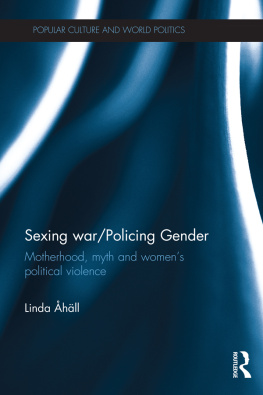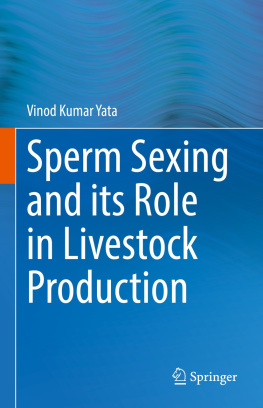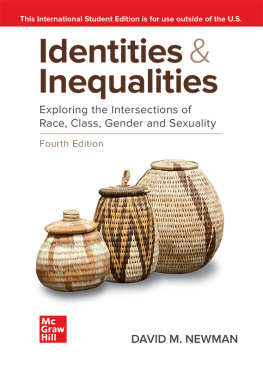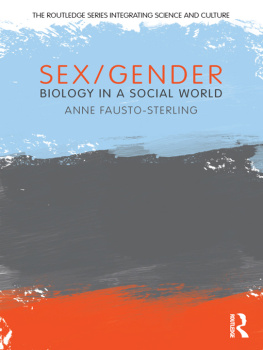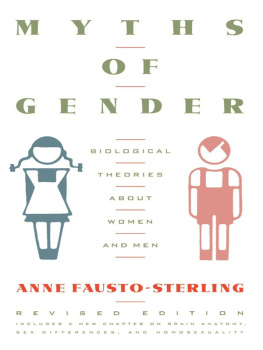Anne Fausto-Sterling - Sexing the Body: Gender Politics and the Construction of Sexuality, Updated Edition
Here you can read online Anne Fausto-Sterling - Sexing the Body: Gender Politics and the Construction of Sexuality, Updated Edition full text of the book (entire story) in english for free. Download pdf and epub, get meaning, cover and reviews about this ebook. year: 2020, publisher: Basic Books, genre: Romance novel. Description of the work, (preface) as well as reviews are available. Best literature library LitArk.com created for fans of good reading and offers a wide selection of genres:
Romance novel
Science fiction
Adventure
Detective
Science
History
Home and family
Prose
Art
Politics
Computer
Non-fiction
Religion
Business
Children
Humor
Choose a favorite category and find really read worthwhile books. Enjoy immersion in the world of imagination, feel the emotions of the characters or learn something new for yourself, make an fascinating discovery.

- Book:Sexing the Body: Gender Politics and the Construction of Sexuality, Updated Edition
- Author:
- Publisher:Basic Books
- Genre:
- Year:2020
- Rating:4 / 5
- Favourites:Add to favourites
- Your mark:
- 80
- 1
- 2
- 3
- 4
- 5
Sexing the Body: Gender Politics and the Construction of Sexuality, Updated Edition: summary, description and annotation
We offer to read an annotation, description, summary or preface (depends on what the author of the book "Sexing the Body: Gender Politics and the Construction of Sexuality, Updated Edition" wrote himself). If you haven't found the necessary information about the book — write in the comments, we will try to find it.
Sexing the Body: Gender Politics and the Construction of Sexuality, Updated Edition — read online for free the complete book (whole text) full work
Below is the text of the book, divided by pages. System saving the place of the last page read, allows you to conveniently read the book "Sexing the Body: Gender Politics and the Construction of Sexuality, Updated Edition" online for free, without having to search again every time where you left off. Put a bookmark, and you can go to the page where you finished reading at any time.
Font size:
Interval:
Bookmark:
Copyright 2000 by Anne Fausto-Sterling
Chapter Ten 2020 by Anne Fausto-Sterling
Afterword 2020 by Anne Fausto-Sterling
Cover design by Chin-Yee Lai
Cover copyright 2020 Hachette Book Group, Inc.
Hachette Book Group supports the right to free expression and the value of copyright. The purpose of copyright is to encourage writers and artists to produce the creative works that enrich our culture.
The scanning, uploading, and distribution of this book without permission is a theft of the authors intellectual property. If you would like permission to use material from the book (other than for review purposes), please contact permissions@hbgusa.com. Thank you for your support of the authors rights.
Basic Books
Hachette Book Group
1290 Avenue of the Americas, New York, NY 10104
www.basicbooks.com
Second paperback edition: June 2020
Published by Basic Books, an imprint of Perseus Books, LLC, a subsidiary of Hachette Book Group, Inc. The Basic Books name and logo is a trademark of the Hachette Book Group.
The Hachette Speakers Bureau provides a wide range of authors for speaking events. To find out more, go to www.hachettespeakersbureau.com or call (866) 376-6591.
The publisher is not responsible for websites (or their content) that are not owned by the publisher.
All uncredited illustrations are from the authors collection and are used with her permission.
Library of Congress Cataloging-in-Publication Data
Names: Fausto-Sterling, Anne, 1944 author.
Title: Sexing the body : gender politics and the construction of sexuality / Anne Fausto-Sterling.
Description: Second edition. | New York : Basic Books, 2020. | Includes bibliographical references and index.
Identifiers: LCCN 2020008744 | ISBN 9781541672895 (paperback) | ISBN 9781541672901 (epub)
Subjects: LCSH: Sex differences. | Gender identity. | Sex differentiation. Intersexuality. | Sex (Biology) | Sex role.
Classification: LCC HQ1075.F39 2020 | DDC 571.8/82dc23
LC record available at https://lccn.loc.gov/2020008744
ISBNs: 978-0-4650-7713-7 (hardcover); 978-0-4650-7714-4 (first trade paperback); 978-1-5416-7289-5 (second trade paperback); 978-1-5416-7290-1 (ebook)
E3-20200519-JV-NF-ORI
For the ever delightful and always stimulating Paula.
You excite my heart and my mind.
Sexing the Body was first published in 2000. In my previous book, Myths of Gender: Biological Theories About Women and Men (1985), I had exhorted scholars to examine the personal and political components of their scholarly viewpoints. Individual scientists are inclined to believe one or another claim about biology based in part on scientific evidence and in part on whether the claim confirms some aspect of life that seems personally familiar. As someone who has lived part of her life as an unabashed heterosexual, part as an unabashed lesbian, and part in transition, I was certainly open to theories of sexuality that allow for flexibility and the development of new behavior patterns, even in adulthood. I did not find it surprising, however, that someone who always felt either heterosexual or homosexual might be more open to theories that posit a biologically determined sexuality that unfolds as one grows into adulthood.
In 1985, however, I had little understanding of how cultural points of view insinuated themselves into the production of scientific knowledge and I felt a need to explore this question in greater detail. The result was a ten-year foray into the field of science and technology studies (STS), an area of inquiry that explores how science itself workshow it produces reliable knowledge even if that knowledge contains cultural biases. As I explored STS ideas, the concepts that led to Sexing the Body took shape in my head. What could it mean to think that biology itself might be socially constructed (as the argument would have been phrased during the 1990s)? How would someone steeped in the concepts developed by STS researchers conceptualize sex, gender, hormones, and genitalia? In 2000 I put forward my thoughts on such topics in Sexing the Body. My goal was to to convince readers of the need for theories that allow for a good deal of human variation and that integrate the analytical powers of the biological and the social into the systematic analysis of human development. Now, twenty years later, Im delighted to have the opportunity to update the book and especially to further develop my thoughts on how humans acquire different identities and ways of being in the world.
Much has changed in the past two decades, from the rapid spread of same-sex marriage to the proliferation of new gender identities and labels. Nevertheless, for this new edition of Sexing the Body, I have chosen not to alter the books original nine chapters. These, I think, still form a coherent argument. Furthermore, they were written at a particular moment in my own intellectual development and focused around the hotly debated arguments in which the field of sex/sexuality and gender studies engaged during the 1990s. It would confuse me and the reader to try to integrate how I think about these same issues in 2020 into text written over twenty years ago. Instead, I have added a new , A Sea of Gender, which offers a contemporary, 2020 roadmap for understanding how gender/sex develops in individuals, and how big-picture patterns of difference and sameness emerge. Then, in a new afterword, I follow into the present some of the topics examined at length in the original chapters. I describe, for example, recent attempts to (again) limit competitive athletics to only certain kinds of womenlooking especially at the International Olympic Committees ban on long-distance women runners who have naturally high testosterone levels. I update the reader on the intersex rights movement and changes in clinical treatment of infants born with mixed genitalia, and I review a rapidly growing literature on gender/sex differences and similarities in the brain.
For a book written for a general audience, this volume has an unusually large notes and bibliography section. That is because, in essence, I have written two books in one: a narrative accessible to a general audience, and a scholarly work intended to advance discussion and arguments within academic circles. At times the scholarly discussion can become arcane or devolve into side issues that deflect attention from the main narrative. Furthermore, academics often demand detailed evidence in the form of quotes from original sources or detailed accounts of a particular experiment. One of the ways I have used the notes is to carry on the scholarly discussions without distracting the general reader. Although one need not do so to follow my general argument, I nevertheless urge everyone to read the notes, as they add both depth and diversity to the text.
Furthermore, Sexing the Body is a highly synthetic work, and thus most readers, be they academicians or members of a general audience, will be unfamiliar withand quite possibly skeptical ofat least some of the areas on which I touch. For this reason, as well, I chose to footnote heavily, indicating that claims I make even in passing have substantial backing in the academic literature. Then, too, readers intrigued with particular topics can use the notes and bibliography as a resource for further reading of their own. This, I fear, is the teacher in me. My biggest desire in writing this book is to stimulate discussion and reading on the part of my readers, so the rich and up-to-date bibliography draws on significant literatures in fields ranging from science studies to feminism to sexuality studies to human development to systems theory and biology.
I have also included a fair amount of artwork, and again this is unusual for a book of this type. Some of the illustrations consist of cartoons or humorous drawings describing events discussed in the text. I was inspired to take this route by others who have conveyed scientific ideas using cartoons. Many people think of science as a humorless profession, and feminists are always accused of lacking a sense of humor. But this feminist scientist finds humor everywhere. I hope that some of the illustrations encourage readers suspicious of the cultures of science and of feminism to see that it is possible to be deeply serious about ones profession while maintaining a sense of humor.
Font size:
Interval:
Bookmark:
Similar books «Sexing the Body: Gender Politics and the Construction of Sexuality, Updated Edition»
Look at similar books to Sexing the Body: Gender Politics and the Construction of Sexuality, Updated Edition. We have selected literature similar in name and meaning in the hope of providing readers with more options to find new, interesting, not yet read works.
Discussion, reviews of the book Sexing the Body: Gender Politics and the Construction of Sexuality, Updated Edition and just readers' own opinions. Leave your comments, write what you think about the work, its meaning or the main characters. Specify what exactly you liked and what you didn't like, and why you think so.

